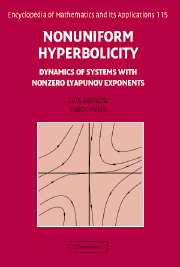Book contents
- Frontmatter
- Contents
- Preface
- Introduction
- Part I Linear Theory
- Part II Examples and Foundations of the Nonlinear Theory
- Part III Ergodic Theory of Smooth and SRB Measures
- Part IV General Hyperbolic Measures
- 14 Hyperbolic Measures: Entropy and Dimension
- 15 Hyperbolic Measures: Topological Proper ties
- Bibliography
- Index
15 - Hyperbolic Measures: Topological Proper ties
from Part IV - General Hyperbolic Measures
Published online by Cambridge University Press: 05 May 2013
- Frontmatter
- Contents
- Preface
- Introduction
- Part I Linear Theory
- Part II Examples and Foundations of the Nonlinear Theory
- Part III Ergodic Theory of Smooth and SRB Measures
- Part IV General Hyperbolic Measures
- 14 Hyperbolic Measures: Entropy and Dimension
- 15 Hyperbolic Measures: Topological Proper ties
- Bibliography
- Index
Summary
In contrast to having just the few, albeit deep, results on ergodic properties of general hyperbolic measures described in the previous chapter, surprisingly many results on their topological properties can be established. They are generalizations to the nonuniformly hyperbolic case of well-known results on the topological behavior of uniformly hyperbolic systems, and the methods are extensions of some techniques widely used in the theory of locally maximal hyperbolic sets. These tools are not only important for applications but also help to reveal a nontrivial geometric structure of measures with nonzero exponents. We explain how one can close recurrent orbits, shadow pseudo-orbits, and determine the cohomology class of Hölder cocycles by periodic data.
The study of topological properties of hyperbolic measures originated in the work of Katok [101]. We follow the presentation in [106]. For C1+α diffeomorphisms possessing a hyperbolic measure, we show that the combination of hyperbolicity with nontrivial recurrence reveals a rich and complicated orbit structure. The main goal is to relate the existence of nonzero Lyapunov exponents with the presence of hyperbolic periodic points, transverse homoclinic points, and hyperbolic horseshoes. One of the most striking results is that the entropy of a hyperbolic measure can be approximated by the topological entropies of (uniformly) hyperbolic invariant sets (see Theorem 15.6.1). The main tools will be the closing lemma (see Theorem 15.1.2) and the recurrence provided by the invariant measures.
- Type
- Chapter
- Information
- Nonuniform HyperbolicityDynamics of Systems with Nonzero Lyapunov Exponents, pp. 463 - 490Publisher: Cambridge University PressPrint publication year: 2007

